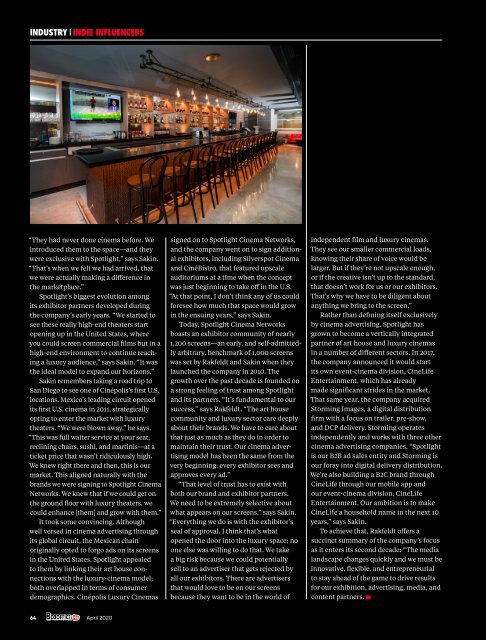Boxoffice Pro - April 2020
Boxoffice Pro is the official publication of the National Association of Theatre Owners.
Boxoffice Pro is the official publication of the National Association of Theatre Owners.
You also want an ePaper? Increase the reach of your titles
YUMPU automatically turns print PDFs into web optimized ePapers that Google loves.
INDUSTRY INDIE INFLUENCES INFLUENCERS<br />
“They had never done cinema before. We<br />
introduced them to the space—and they<br />
were exclusive with Spotlight,” says Sakin.<br />
“That’s when we felt we had arrived, that<br />
we were actually making a difference in<br />
the marketplace.”<br />
Spotlight’s biggest evolution among<br />
its exhibitor partners developed during<br />
the company’s early years. “We started to<br />
see these really high-end theaters start<br />
opening up in the United States, where<br />
you could screen commercial films but in a<br />
high-end environment to continue reaching<br />
a luxury audience,” says Sakin. “It was<br />
the ideal model to expand our horizons.”<br />
Sakin remembers taking a road trip to<br />
San Diego to see one of Cinépolis’s first U.S.<br />
locations. Mexico’s leading circuit opened<br />
its first U.S. cinema in 2011, strategically<br />
opting to enter the market with luxury<br />
theaters. “We were blown away,” he says.<br />
“This was full waiter service at your seat,<br />
reclining chairs, sushi, and martinis—at a<br />
ticket price that wasn’t ridiculously high.<br />
We knew right there and then, this is our<br />
market. This aligned naturally with the<br />
brands we were signing to Spotlight Cinema<br />
Networks. We knew that if we could get on<br />
the ground floor with luxury theaters, we<br />
could enhance [them] and grow with them.”<br />
It took some convincing. Although<br />
well versed in cinema advertising through<br />
its global circuit, the Mexican chain<br />
originally opted to forgo ads on its screens<br />
in the United States. Spotlight appealed<br />
to them by linking their art house connections<br />
with the luxury-cinema model;<br />
both overlapped in terms of consumer<br />
demographics. Cinépolis Luxury Cinemas<br />
signed on to Spotlight Cinema Networks,<br />
and the company went on to sign additional<br />
exhibitors, including Silverspot Cinema<br />
and CinéBistro, that featured upscale<br />
auditoriums at a time when the concept<br />
was just beginning to take off in the U.S.<br />
“At that point, I don’t think any of us could<br />
foresee how much that space would grow<br />
in the ensuing years,” says Sakin.<br />
Today, Spotlight Cinema Networks<br />
boasts an exhibitor community of nearly<br />
1,200 screens—an early, and self-admittedly<br />
arbitrary, benchmark of 1,000 screens<br />
was set by Rakfeldt and Sakin when they<br />
launched the company in 2010. The<br />
growth over the past decade is founded on<br />
a strong feeling of trust among Spotlight<br />
and its partners. “It’s fundamental to our<br />
success,” says Rakfeldt. “The art house<br />
community and luxury sector care deeply<br />
about their brands. We have to care about<br />
that just as much as they do in order to<br />
maintain their trust. Our cinema advertising<br />
model has been the same from the<br />
very beginning: every exhibitor sees and<br />
approves every ad.”<br />
“That level of trust has to exist with<br />
both our brand and exhibitor partners.<br />
We need to be extremely selective about<br />
what appears on our screens,” says Sakin.<br />
“Everything we do is with the exhibitor’s<br />
seal of approval. I think that’s what<br />
opened the door into the luxury space; no<br />
one else was willing to do that. We take<br />
a big risk because we could potentially<br />
sell to an advertiser that gets rejected by<br />
all our exhibitors. There are advertisers<br />
that would love to be on our screens<br />
because they want to be in the world of<br />
independent film and luxury cinemas.<br />
They see our smaller commercial loads,<br />
knowing their share of voice would be<br />
larger. But if they’re not upscale enough,<br />
or if the creative isn’t up to the standard,<br />
that doesn’t work for us or our exhibitors.<br />
That’s why we have to be diligent about<br />
anything we bring to the screen.”<br />
Rather than defining itself exclusively<br />
by cinema advertising, Spotlight has<br />
grown to become a vertically integrated<br />
partner of art house and luxury cinemas<br />
in a number of different sectors. In 2017,<br />
the company announced it would start<br />
its own event-cinema division, CineLife<br />
Entertainment, which has already<br />
made significant strides in the market.<br />
That same year, the company acquired<br />
Storming Images, a digital distribution<br />
firm with a focus on trailer, pre-show,<br />
and DCP delivery. Storming operates<br />
independently and works with three other<br />
cinema advertising companies. “Spotlight<br />
is our B2B ad sales entity and Storming is<br />
our foray into digital delivery distribution.<br />
We’re also building a B2C brand through<br />
CineLife through our mobile app and<br />
our event-cinema division, CineLife<br />
Entertainment. Our ambition is to make<br />
CineLife a household name in the next 10<br />
years,” says Sakin.<br />
To achieve that, Rakfeldt offers a<br />
succinct summary of the company’s focus<br />
as it enters its second decade: “The media<br />
landscape changes quickly and we must be<br />
innovative, flexible, and entrepreneurial<br />
to stay ahead of the game to drive results<br />
for our exhibition, advertising, media, and<br />
content partners.<br />
64<br />
<strong>April</strong> <strong>2020</strong>

















